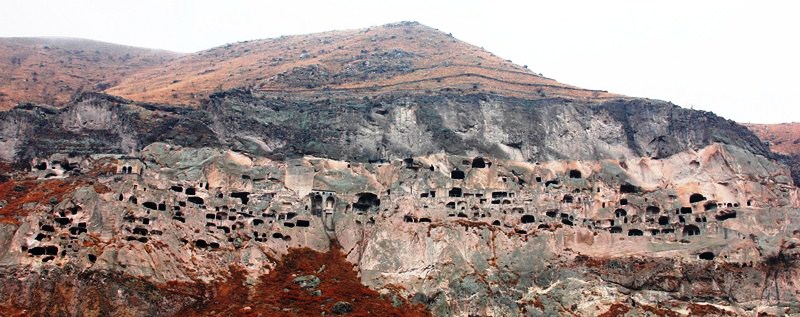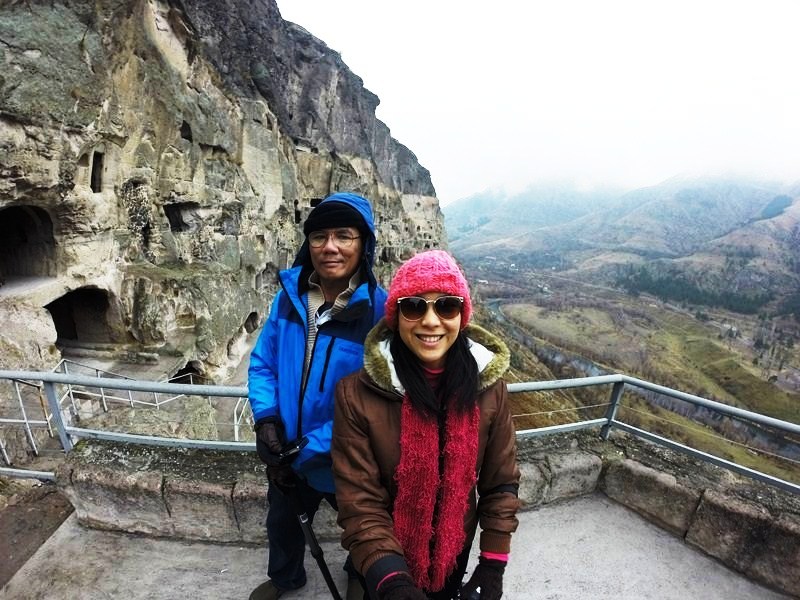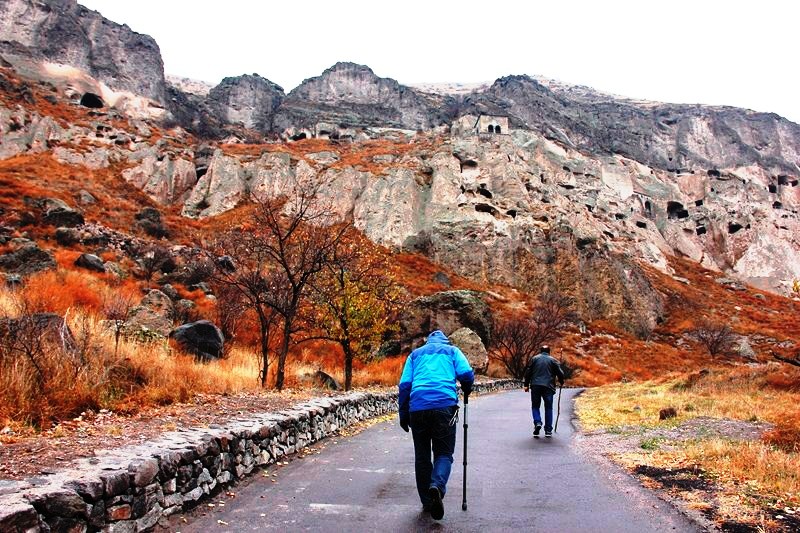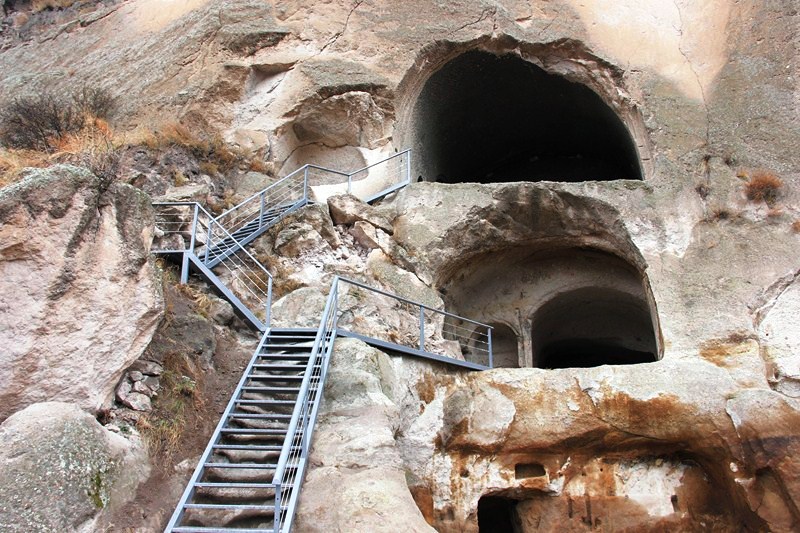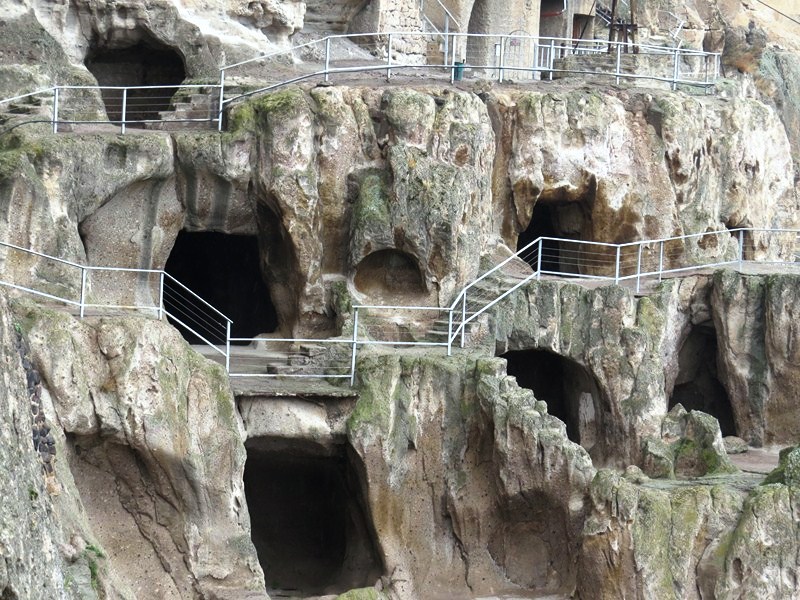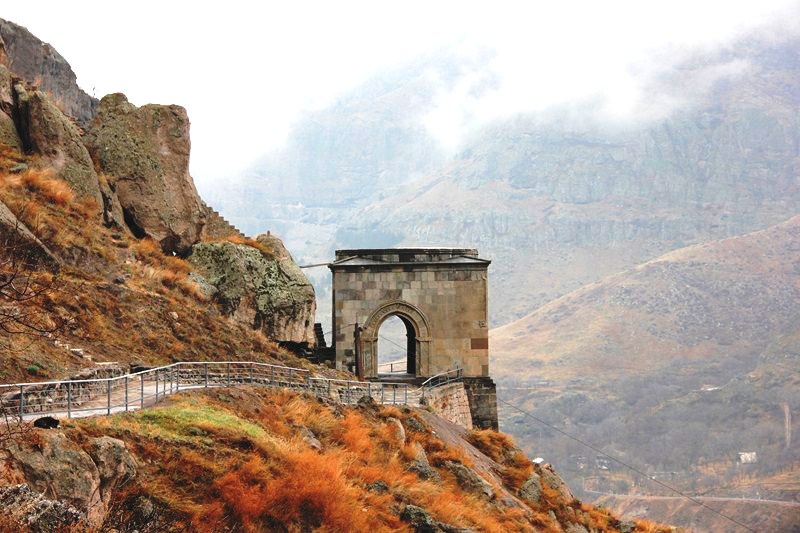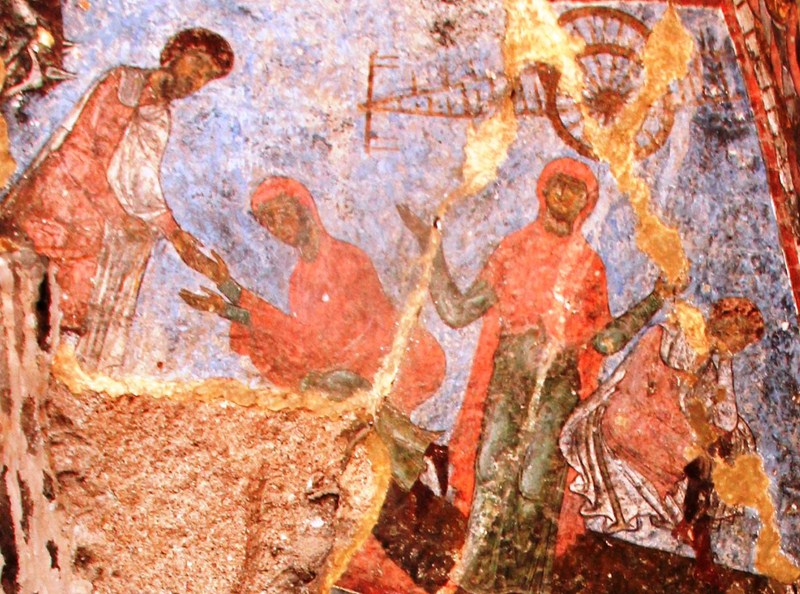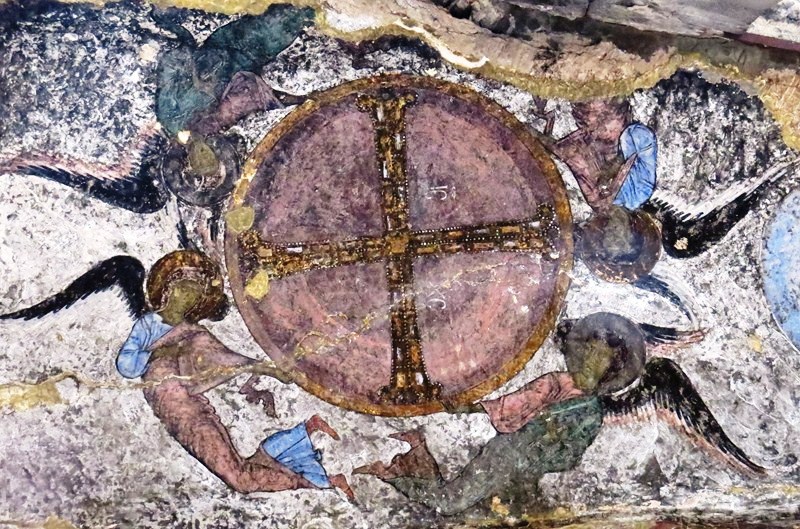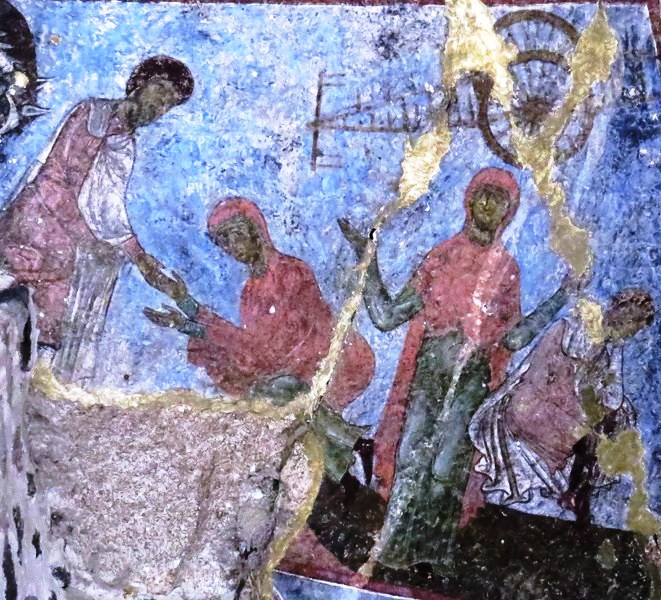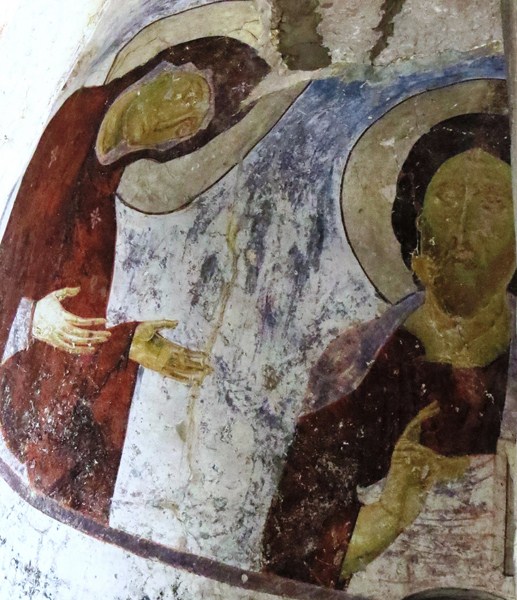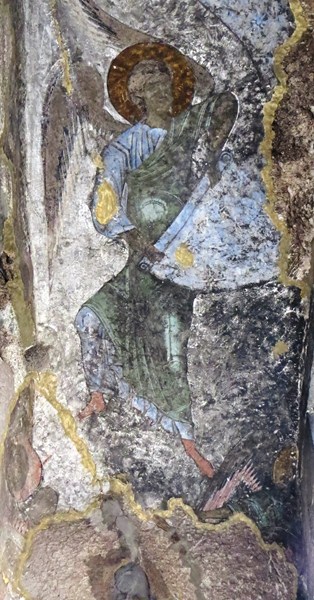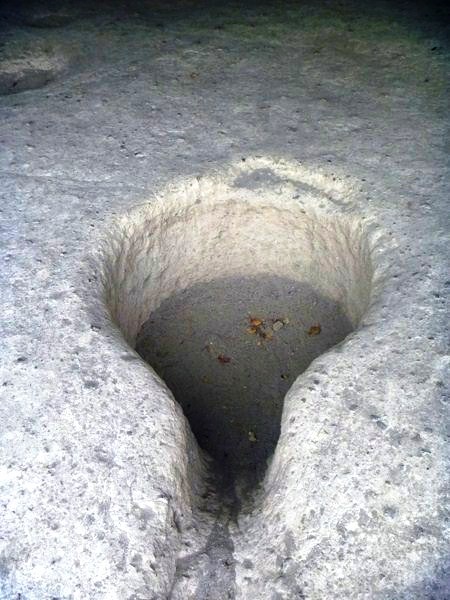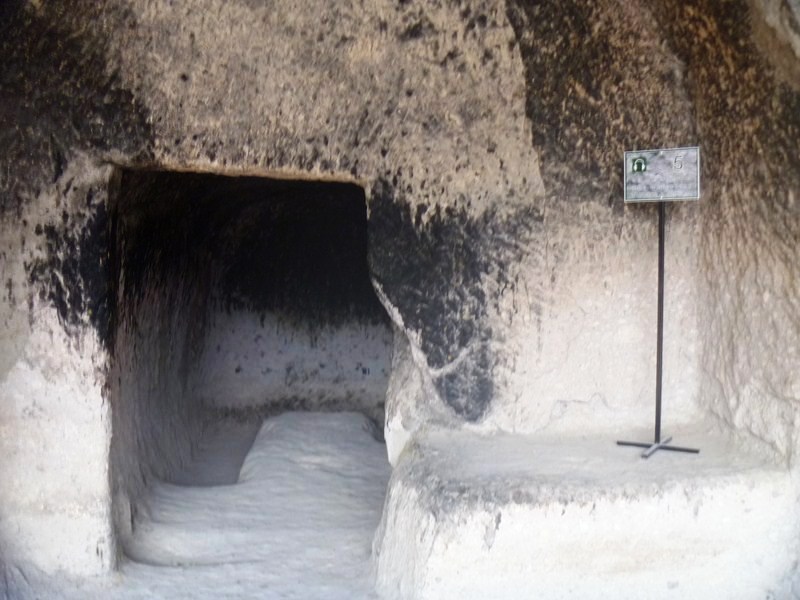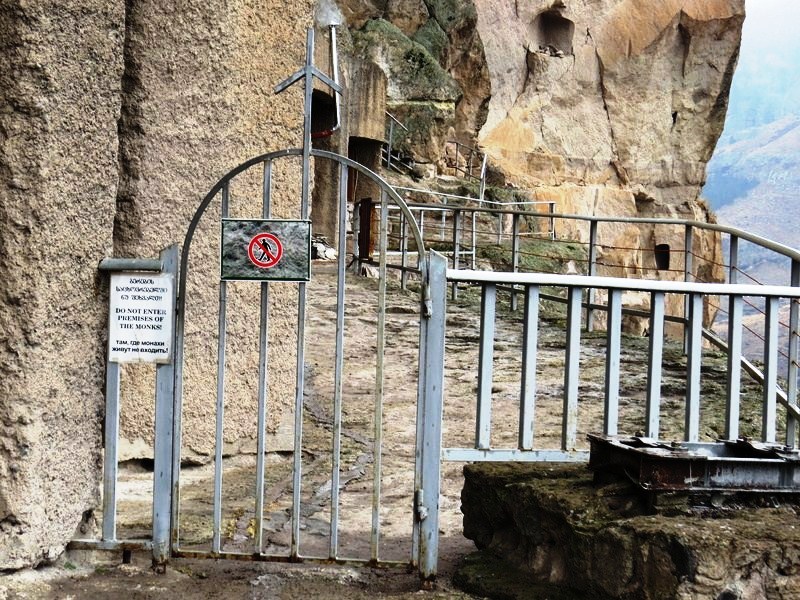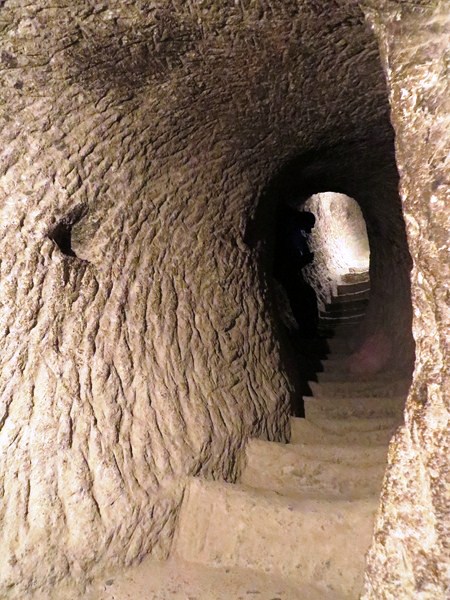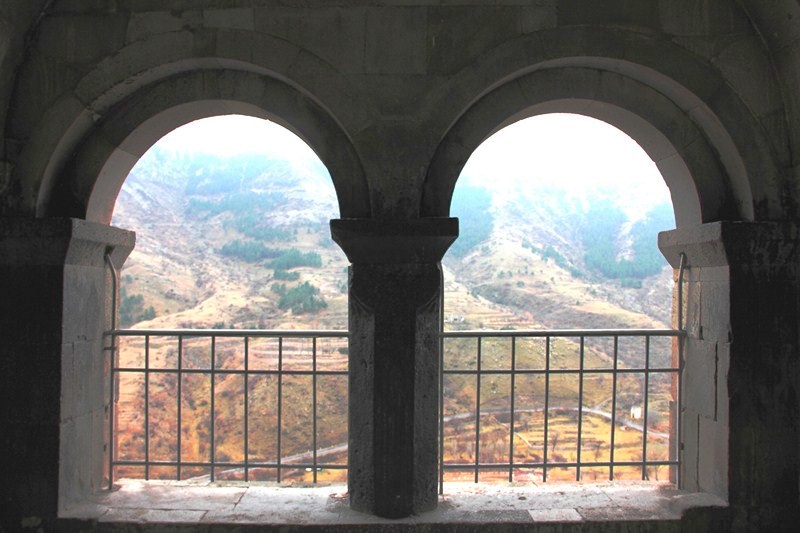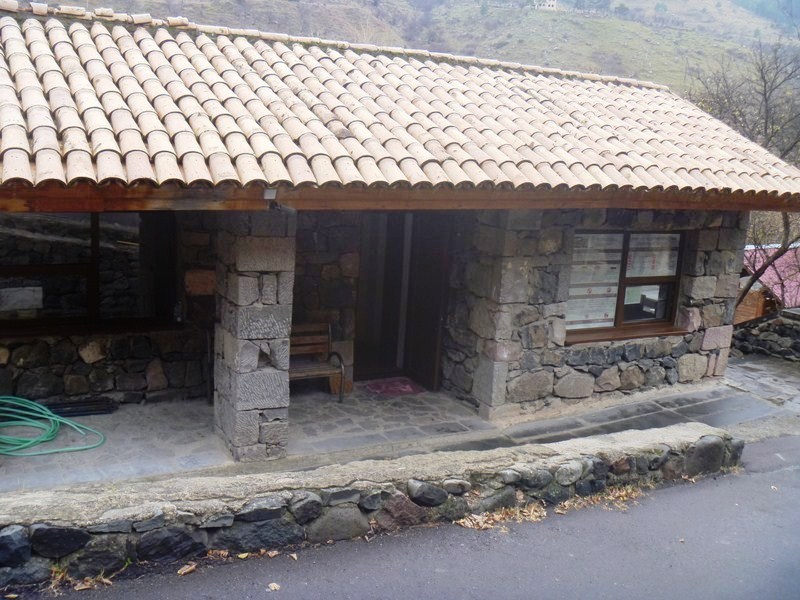From Akhaltsikhe, it was a fantastic drive up to Vardzia, with old castles and churches along the way. Soon, we espied the wide-mouthed caves gaping at us from across the valley as we drove in. Vardzia, on the left bank of the Mtkvari River, 30 kms. from the town of Aspindza, was excavated from solid rock along the slopes of the Erusheti Mountain during the second half of the 12th century. The caves, stretching along the cliff for some 500 m., rises up to 19 tiers.
Four distinct building phases have been identified at Vardzia. The first phase, during the reign of Giorgi III (1156-1184), was when the site was laid out and the first cave dwellings excavated; the second between Giorgi’s death and the marriage of fabled queen Tamar, his successor, in 1186 (when the Church of the Dormition was carved out and decorated); the third from that date until Tamar’s victory at the Battle of Basian (circa 1203), during which time many more dwellings as well as the defenses, water supply, and a complex irrigation network ( to water fertile, terraced farmlands on the outside slopes) were constructed.
The fourth phase was a period of partial rebuilding, after the devastating earthquake of 1283 literally ripped the place apart, shattering the mountain slope, destroying more than two-thirds of the city and exposing the hidden innards of the remainder. Vardzia escaped the onslaught of the Mongol invaders in the 1290s and the monastery community persisted until it was sacked by the Persians, under Shah Tahmasp I, in 1551. After the Ottoman takeover in the 16th century, the site was largely abandoned.
The greater Vardzia area includes also the early 11th-century church at Zeda Vardzia and the 10th to 12th-century rock village and cave churches of Ananuri. The main lower site, carved from the cliff’s central stratum of tufaceous breccia at an elevation of 1,300 m. above sea level, is divided, into an eastern and a western part, by the Church of the Dormition. In the eastern part of the complex are 79 separate cave dwellings, in 8 tiers, with a total of 242 rooms, including 6 chapels, “Tamar’s Room,” a meeting room, reception chamber, pharmacy and 25 wine cellars (185 wine jars sunk into the floor document the importance of viticulture to the monastic economy).
In the western part, between the external bell tower and the large main church, are a further 40 houses, in 13 tiers, with a total of 165 rooms, including 6 chapels, a refectory with a bakery, other ovens for baking bread, and a forge. Beyond the bell tower, the complex rises to 19 tiers, with steps leading to a cemetery. Infrastructure includes access tunnels, water facilities and provision for defense. It is assumed that the only access to this mountain stronghold was via a hidden tunnel whose entrance was near the banks of the Mtkvari River.
The Church of the Dormition, the central spiritual and monumental focus of the site, is sometimes known as the Church of the Assumption, which corresponds with the Orthodox Feast of the Dormition. It dates to the 1180s and was erected by Tamar to house the icon of the Virgin of Vardzia after receiving divine help in her campaigns. It has an important series of wall paintings. Similarly carved from the rock, with walls reinforced in stone, the church is 8.2 m. (27 ft.), 14.5 m. (48 ft.) long and has a height of 9.2 m. (30 ft.).
The wall paintings of the church and narthex, not frescoes but executed in secco, are of crucial significance in the development of the Medieval Georgian mural painting. Ascribed to Rati Surameli, eristavi of Kartli, portraits of him, as well as royal founders Giorgi III alongside her niece Tamar, are commemorated on the north wall. Tamar lacks the ribbon that is the attribute of a married woman. Her inscription includes the formula “God grant her a long life.” Giorgi, on the other hand, does not. The paintings are dated to between Giorgi’s death in 1184 and Tamar’s marriage in 1186.
At the vaults and upper walls are episodes, in a sequence, from the life of Christ (Annunciation, followed by the Nativity, Presentation in the Temple, Baptism, Transfiguration, Raising of Lazarus, Triumphal Entry into Jerusalem, Last Supper, Washing of the Feet, Crucifixion, Harrowing of Hell,Ascension, Descent of the Holy Spirit and Dormition).
At a lower level, more accessible as intercessors, are paintings of saints and stylites. On the sanctuary’s rear wall, behind the altar, are Twelve Church Fathers while in the narthex are scenes of the Last Judgment, Bosom of Abraham, Angels bearing a Medallion with the Cross, and 3 scenes from the life of Saint Stephen. Other paintings were lost during the 1283 earthquake.
Since 1985 the site has formed part of the Vardzia Historical–Architectural Museum-Reserve, which includes 46 architectural sites, 12 archaeological sites, and 21 sites of monumental art. In 1999, the extended area of Vardzia-Khertvisi, now part of a state heritage reserve, has been submitted for future inscription on the UNESCO World Heritage List as a Cultural Site. In 2007, it was resubmitted as a mixed Cultural and Natural Site.
From 2012, conservation of the wall paintings in the Church of the Dormition was carried out by the Courtauld Institute of Art in conjunction with the National Agency for Cultural Heritage Preservation of Georgia and Tbilisi State Academy of Arts. Today, the place is maintained by a small group of zealous monks. About 300 (out of 6,000) apartments and halls can be visited and, in some tunnels, the old irrigation pipes still bring drinkable water.
Upon arrival, Ruby opted to stay behind at the parking lot (she has been to Vardzia before) while Riva and I walked up a path whose initial approach leads steeply uphill for 30-40 m. up. It was not easy climbing, but we wore good shoes and I brought along my trekking pole (actually a monopod). As we went through the caves at Vardzia, we walked up and down very steep, narrow and low corridors and stairs, most deformed with time. Some of the balconies we passed by were also not fenced (truly not for the faint of heart). We sometimes went through tunnels in near total darkness.
Though the earthquake destroyed a significant part of this cave city carved into the mountainside, what remains was still an unbelievable sight and quite unique and truly amazing to behold. Vardzia looks like it was taken directly from the pages of Lord of the Rings. All I can really say was “Wow.” Walking around and seeing the caves, and the connections between them, was truly mind blowing. The views of the valley are interesting and unbelievable, and the combination of architectural buildings and the caves is astonishing. The most surprising part of our visit was the lack of other visitors. For about 2 hours, Riva and I explored the caves and paths on the mountain but we encountered less than 20 people!
Vardzia: Samtskhe-Javakheti, Georgia. Open daily (except Mondays), 10 AM – 7 PM. Admission: 3 GEL (adults), 1 GEL (students), 2 GEL (group of 10 person or more).
How To Get There: From Tblisi, take a marshrutka (minibus) from Digomi Bus station to Akhaltsikhe. Travel time is about 3 to 4 hours and fare is 12 GEL. From Akhaltsekhi, take another marshrutka to Vardzia. Travel time is an hour and costs 6 GEL. For Vardzia, the taxi (worth it if you are a group of 3 to 4 people that can share the fare) is the easiest mode of transport while a marshrutka the second best option. The last marshrutka from Akhaltsikhe for Vardzia leaves at 1:20 pm. Be there 10 minutes earlier as, once full, the marshrutka will depart earlier. The marshrutkas operate 3 times a day. Leave Tbilisi by 7 AM so that you can reach Akhaltsikhe by 10 AM and catch the marshrutka leaving for Vardzia at 10:30 AM and return to Akhaltsikhe via the last marshrutka at 3 PM. The last marshrutka for Tbilisi from Akhaltsekhi departs at 7 PM.
Qatar Airways has daily flights from Diosdado Macapagal International Airport (Clark, Pampanga) to Tbilisi (Republic of Georgia) with stopovers at Hamad International Airport (Doha, Qatar, 15 hrs.) and Heydar Aliyev International Airport (Baku, Azerbaijan, 1 hr.). Website: www.qatarairways.com.

